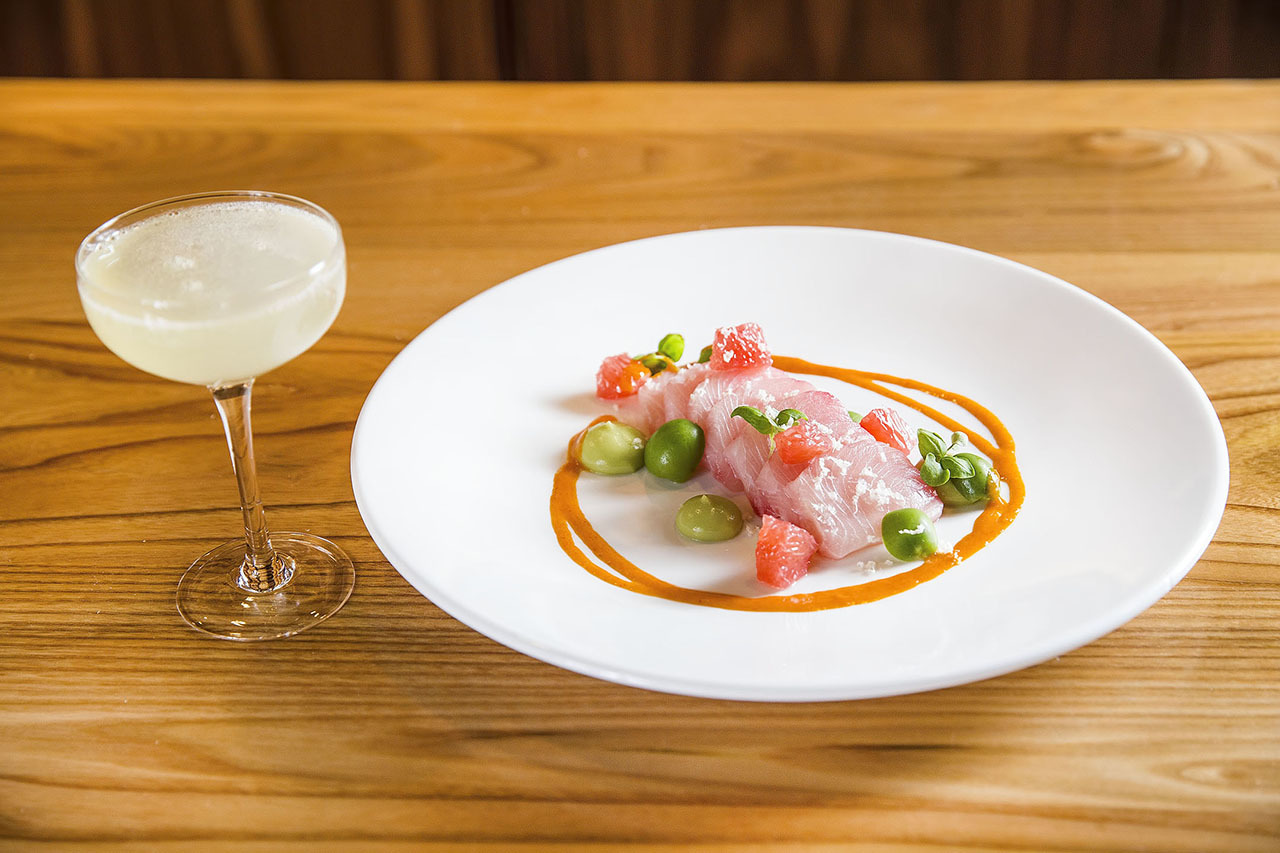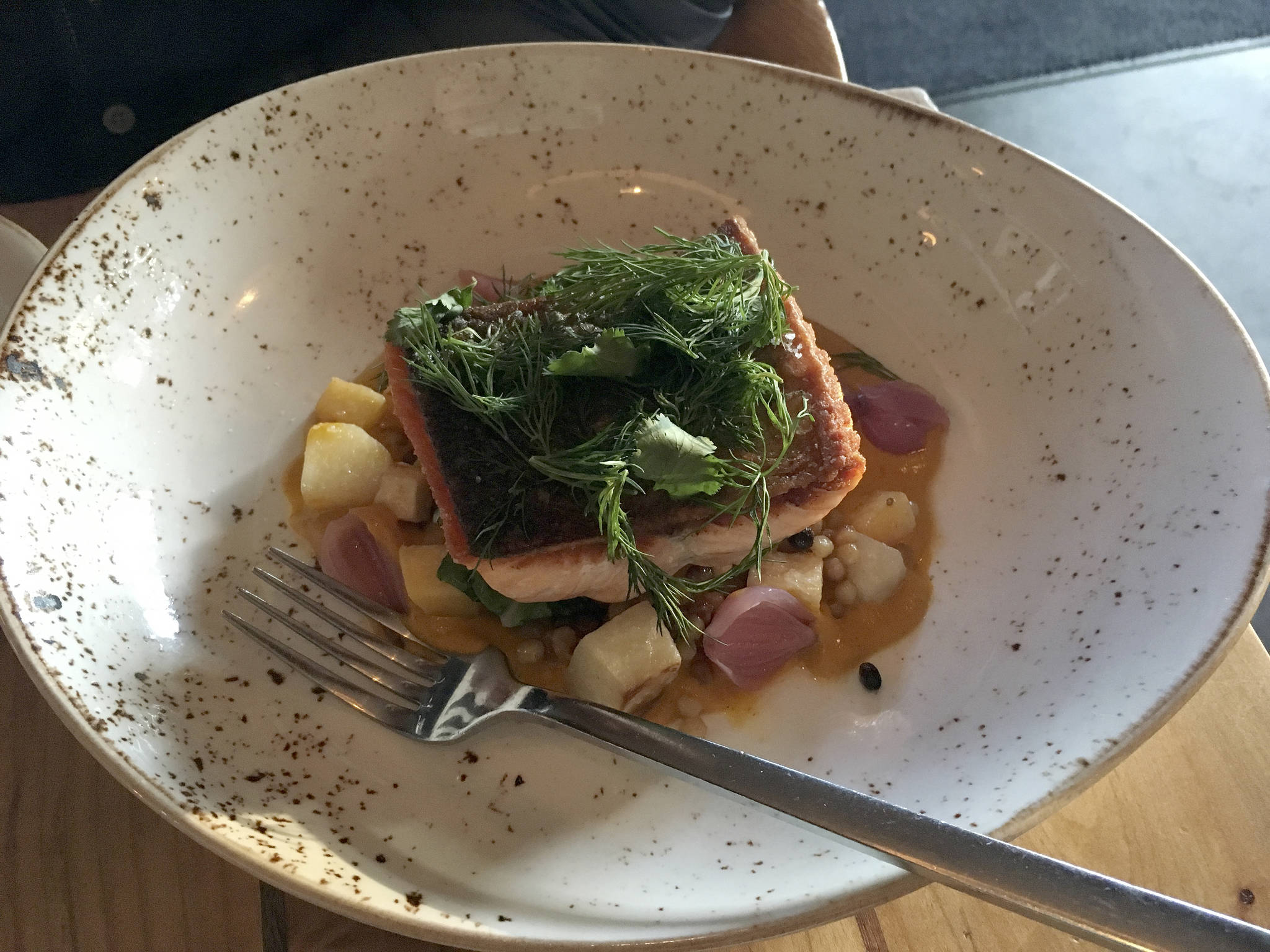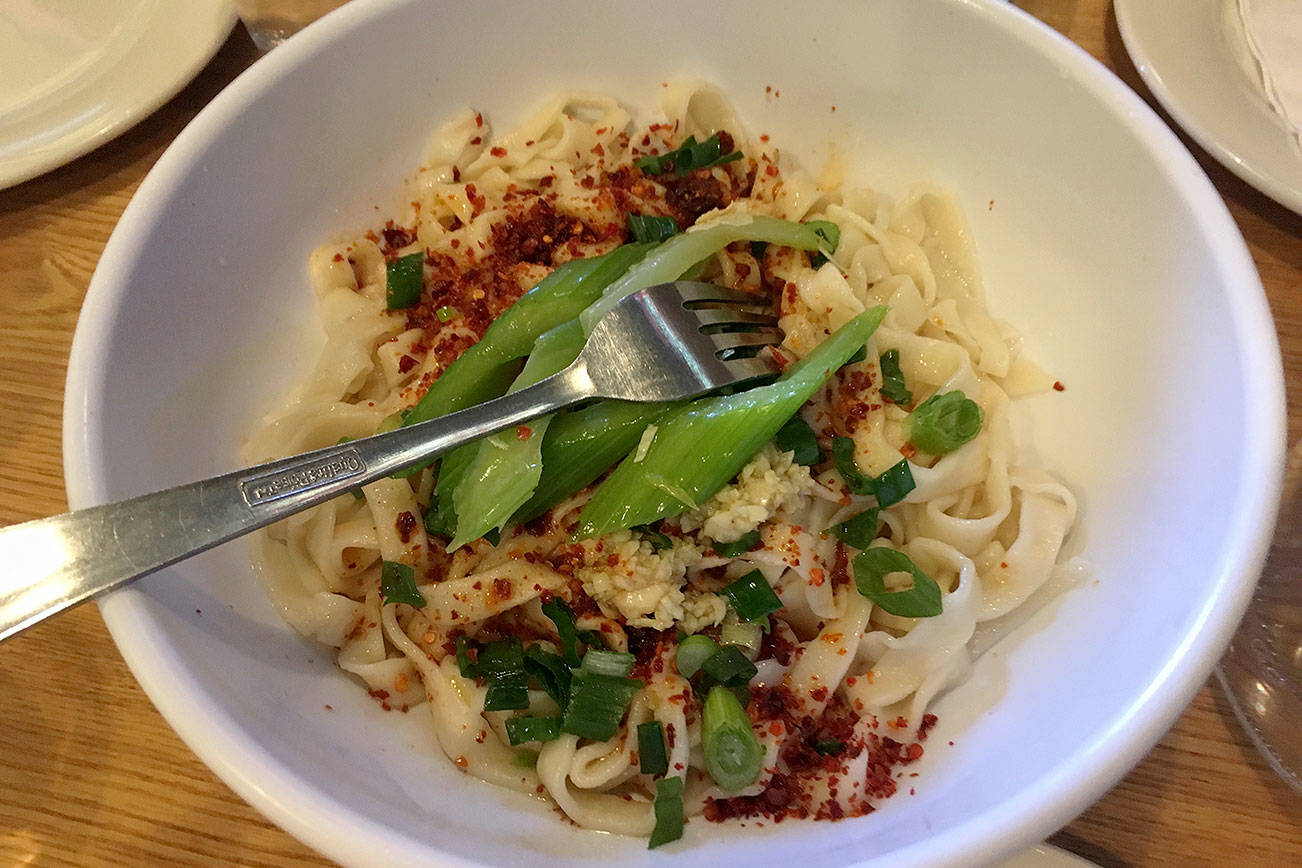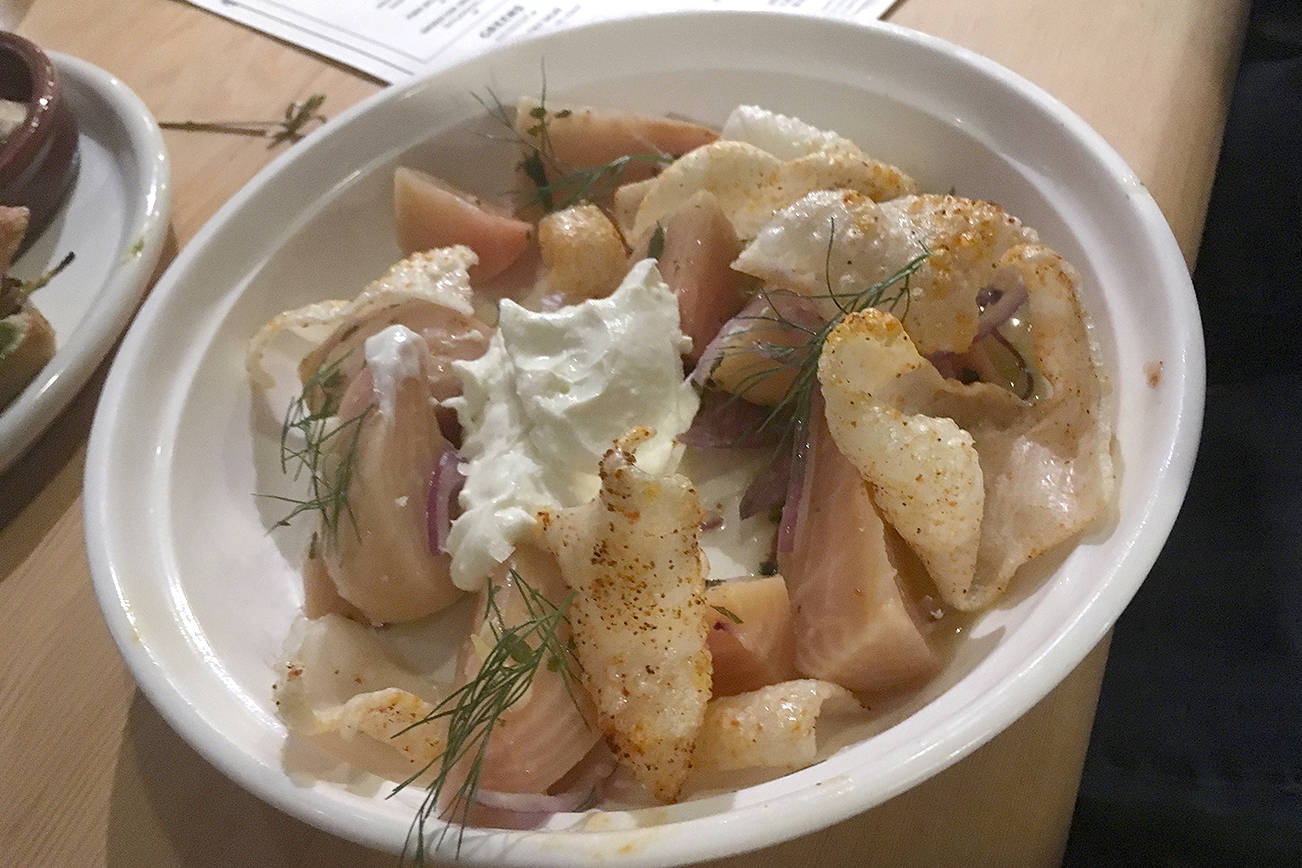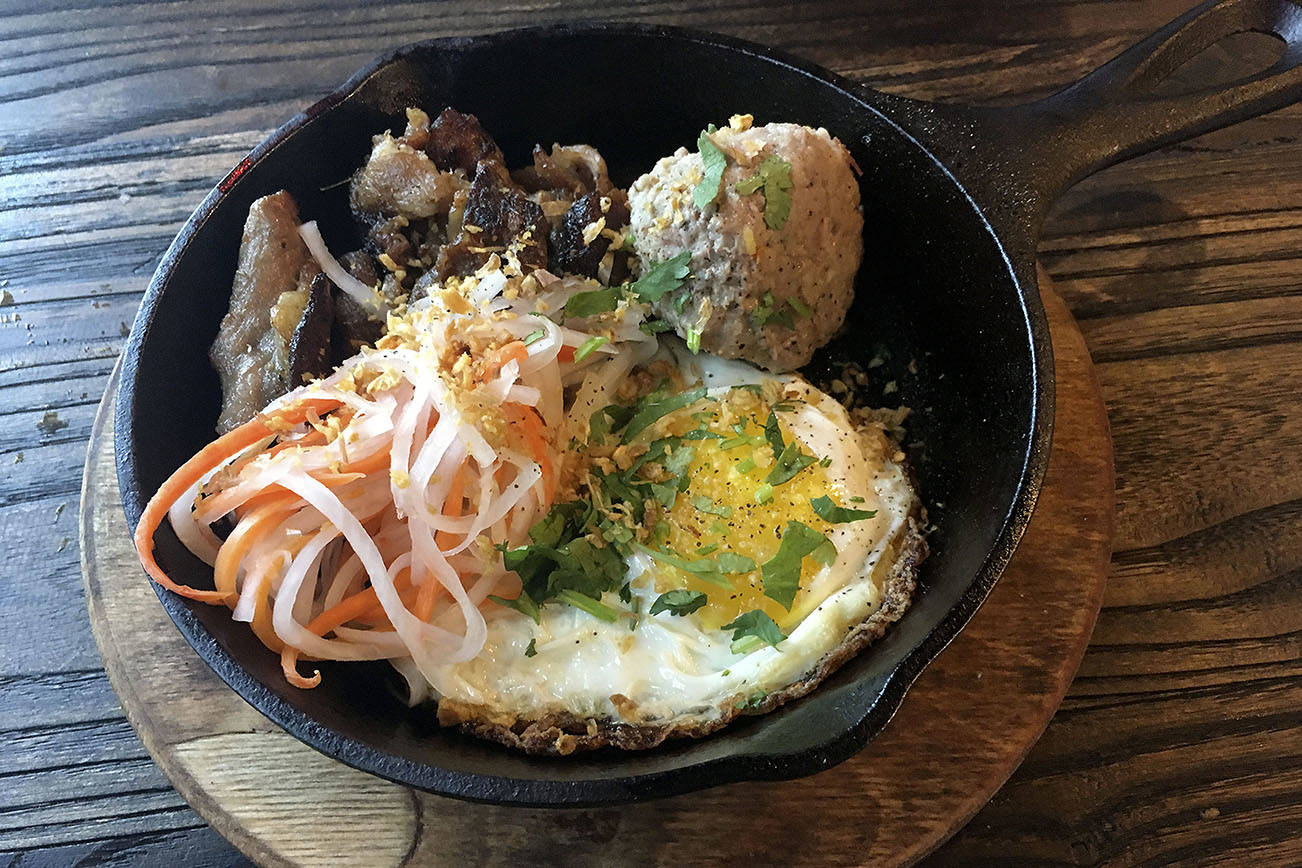Heartwood Provisions (1103 First Ave., 582-3505) is a smart new downtown restaurant that offers an experience not yet found elsewhere in Seattle: optional cocktail pairings with each appetizer, entrée, and dessert, curated by beverage director and award-winning bartender Amanda Reed.
Before I break down the cocktail-pairing experience, let me first say that everything about this establishment has been meticulously thought-out and conveys refinement—from the solid, square wood pillars and the sophisticated lighting to the hefty silverware and the understated navy-blue linen napkins that quietly mirror the barely-blue velvet and leather banquettes. It is, above all else, handsome with a capital H—and that striking attention to detail is present as well on the menu, conceived by chef Varin Keokitvon, formerly of Farestart, and billed as contemporary American with a focus on seasonal ingredients.
From the Raw section of the menu, where you’ll find both fish and beef choices, come jewels of albacore tuna gleaming red against small bites of white pear flesh and tossed with a captivating mix of lime, basil, and aji amarillo, the latter of which (a pepper) brings considerable heat but complements the sweet pear and the sour lime. Scattered throughout are bits of crispy quinoa that crackle pleasingly in your mouth and add a pop of texture. It’s pricey at $17, but the portion is just right and the quality and thoughtfulness of ingredients is worth every dollar. The roasted cauliflower pasta, under Vegetables, isn’t as notable, though still tasty. Beneath a sizable bundle of linguini lies a “garlic-ink” confit, essentially garlic with black squid ink, that you’re to mix into the dish yourself. There isn’t much cauliflower present, though a server told us that it’s in the pasta sauce itself, which also contains capers, lemon, and anchovy crumbs. Unfortunately, all these tart and briny elements nullify the humble, mild-mannered cauliflower. I’d ditch the vegetable altogether and just call it garlic-ink confit pasta.
As for main dishes, under Meat and Seafood, the roasted scallops with a Meyer lemon vinaigrette, mache, sprouted lentils, and sea beans is a pitch-perfect dish and evidence of how conspicuously well-executed this menu is. The scallops are tender and seared, while the sprouted lentils feel creative and new and bring a fresh, vegetal element to the plate that I’ve never experienced with a scallop dish before. If the lemon vinaigrette is a tad puckering, the cocktail it comes with tones it down—surprising, since it also contains lemon: The gin-based drink with vermouth, elderflower, lemon, and the aperitif Salers Gentiane (made from gentian root and white wine) has a bittersweet flavor that immediately softens the acidic sauce. It also softened my skepticism of the cocktail-pairing concept.
So here’s how it works. Each dish comes with a suggested cocktail, most on the light side, featuring vermouths and intriguing aperitifs and liqueurs. They are $6 to $7 only, though at 2.5 ounces slightly smaller than a typical cocktail. But that barely matters; they feel substantial and I loved that I could have quite a few without getting toasted. If the food-pairing conceit doesn’t work for you (and not every one did), consider it a great way to try some really interesting drinks for much less than the usual $12 craft cocktail. The ricotta gnudi—gnocchi-like, creamy ricotta-filled dumplings with an assertive stew-like braised lamb shank, fava beans, and mint—are paired with a cognac, amaro, and sherry-based cocktail that has the most unusual cumin profile due to the addition of kümmel, a clear liqueur with cumin, caraway seed, and fennel. On its own it’s on the sweet side (from the sherry), but paired with the gamy lamb, its Middle Eastern character is bracingly present.
Surprisingly, the server, asked to explain the pairings, recommended we do them only with the starters and opt for wine with the main dishes. When we curiously inquired why, she explained that the richer dishes, presumably the lamb, steak, and pork chop, were better suited to wine—and that the more refreshing cocktails didn’t necessarily make sense with those dishes. I understand her logic, but it undermined the entire concept and made my “Is this just shtick?” radar come roaring on. As a restaurant, you need to own it or scrap it. Perhaps the server might simply remind people that a lovely wine list also exists.
Dessert was a rhubarb shortcake that actually seems more like pound cake (delicious nonetheless), small squares of it sharing space with hearty pieces of poached rhubarb and sweetened with a white-chocolate mousse on top. All of it lies above lemon ice cream. The server pours a warm rhubarb sauce over it tableside, a nice touch in an era where desserts are typically a second thought at best.
Overall, the restaurant feels thoroughly downtown. It has that corporate-expense-account vibe, but would also make a good choice for dinner before a show at Benaroya Hall. That said, an underlying blandness in its perfection could easily turn off Seattle diners who seek more personality and quirk in their dining experiences, or who fret that Seattle has lost its edge. If it seems strange to fault a restaurant for that, it’s only because Seattle is filled with places where unique charms are abundant. Ultimately, though, there’s something to be said for a restaurant where your confidence in each and every plate is unquestioned, and where even the physical menu itself gets a (literal) stamp of quality—the restaurant’s embossed logo proudly but subtly present.
